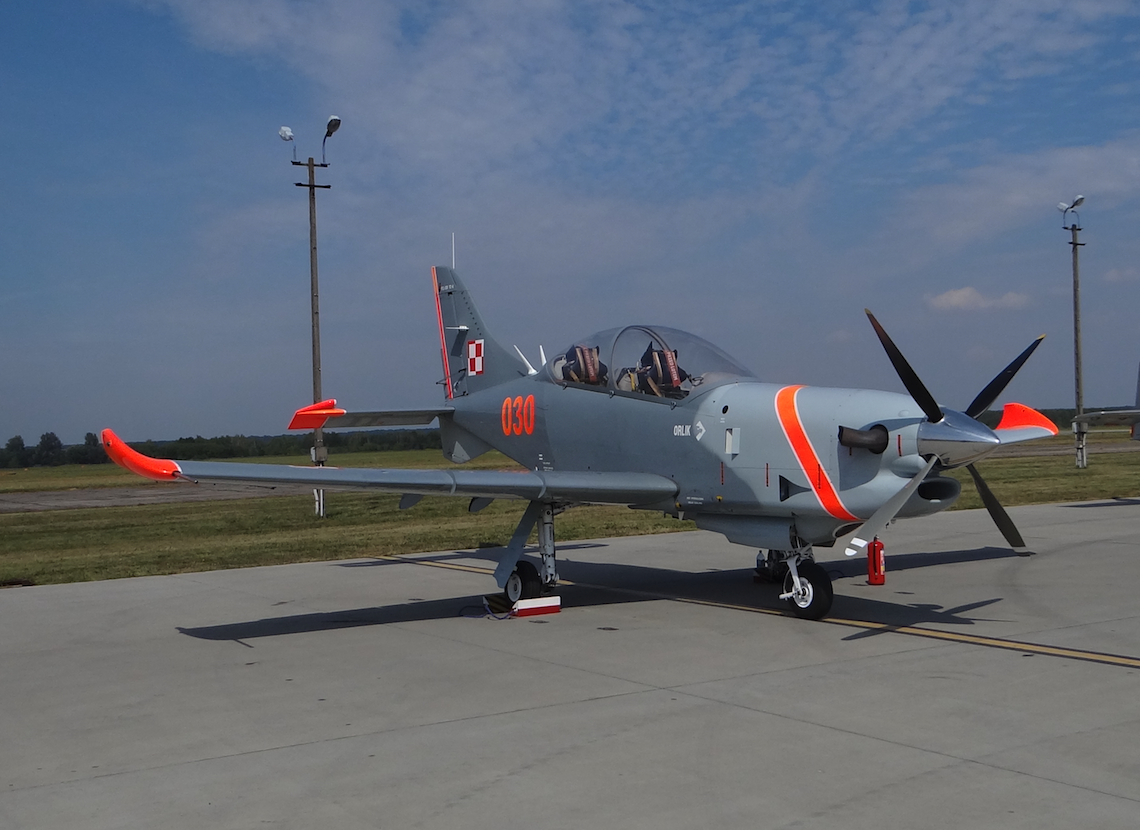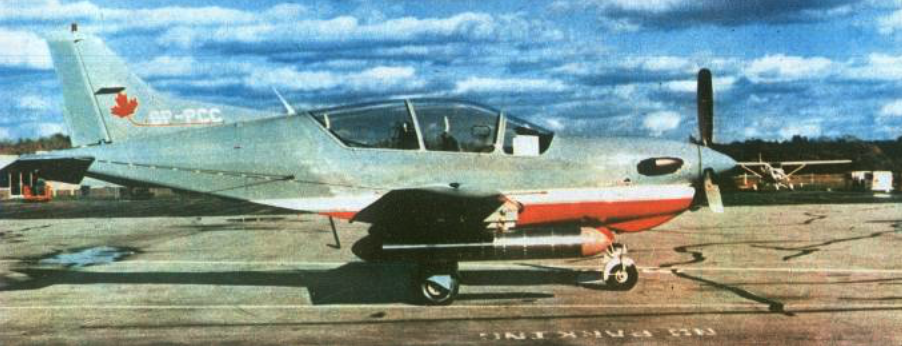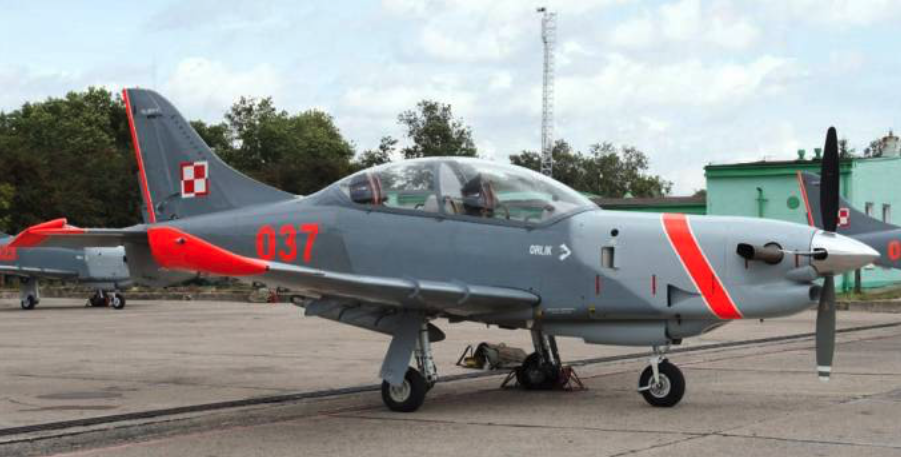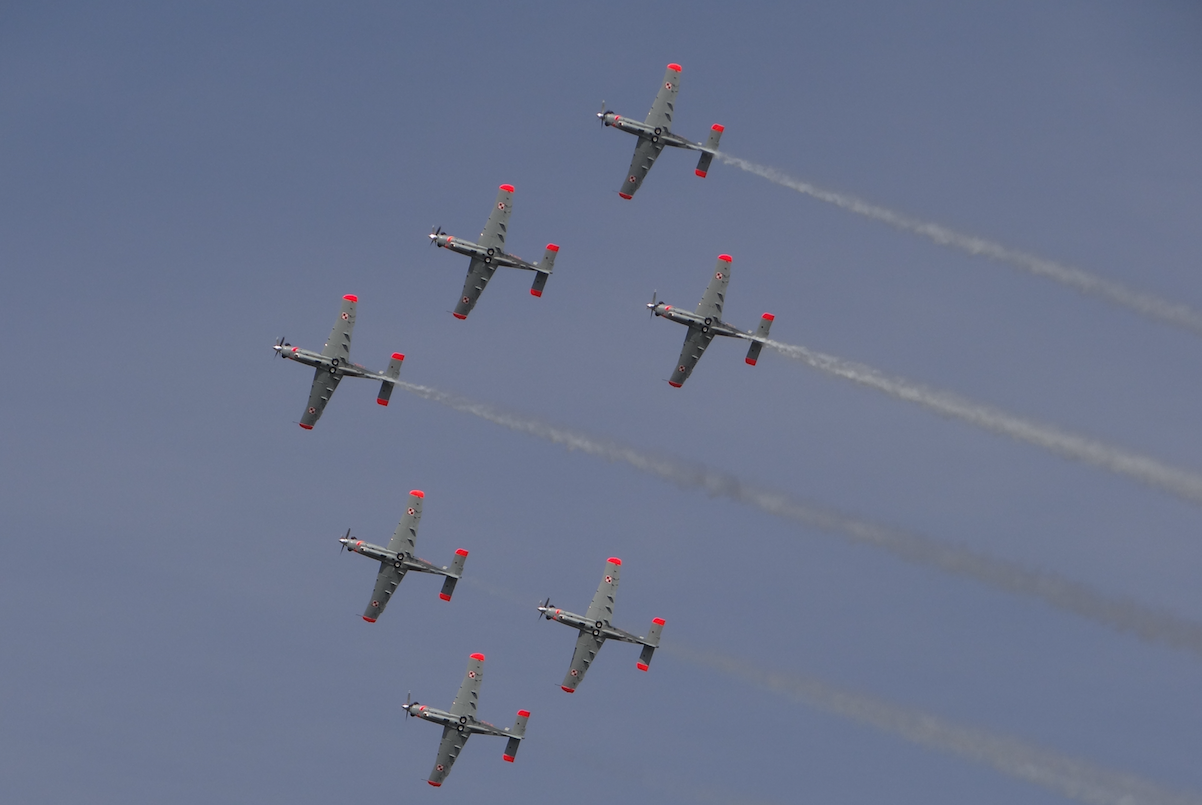Kraków 2008-09-05
267b Section 1986-07-13
PZL-130 Orlik Turbo, engine Pratt-Whitney.
Poland
History
Pratt & Whitney turboprop aircraft.
PZL-130 Orlik aircraft with a Pratt-Whitney turboprop engine.
In 1985, work on a version of the Orlik aircraft equipped with a turboprop engine was far advanced. The first flight was planned in mid-1986. This version of the aircraft was prepared jointly with Airtech-Canada. This was not unusual, as WSK PZL-Warszawa-Okęcie has cooperated with Airtech-Canada for years. The Pratt-Whitney PT 6 A-25 A engine with 410 kW (550 HP) was selected, with a Hartzell HC-B3TN-3B / T10173K-11R three-blade propeller. The propeller has three blades with variable pitch. The diameter is 2.38 m.
The main work was carried out in Canada, in Peterborough and Ontario. In November 1985, aircraft No. 004 registration SP-PCC was sent by sea to Canada. In December 1985, this aircraft was tested to obtain comparative material for a new, not yet existing version. The aircraft was rebuilt. This was done by a small group of Polish specialists representing all necessary fields.
In the final stage of work, the whole was managed by the creator of the Orlik aircraft, mgr inż. Andrzej Frydrychewicz. The elements needed for reconstruction were made in Poland and sent by sea to Canada. They were; engine mount, engine covers, hydraulic system cylinders and others. However, a number of items were made on-site in Canada. The reconstruction was completed in mid-1986.
In addition to the new Turbo power unit, Orlik has received changed installations. Instead of a pneumatic system, a hydraulic system was used. The electrical installation has been completely replaced. An oxygen installation was built up. The fuel system was supplemented with two tanks suspended under the wings to extend the range. The wing structure was strengthened and four fastening catches were installed, for example: armament (including two for additional tanks). Other changes include: Increased inflow in front of the vertical stabilizer. Rich King avionics were built.
The first flight named Turbo Orlik made on 1986-07-13. Other sources say 1986-07-16. The pilot of the aircraft was the experimental pilot MSc. Jerzy Wojnar.
Obtaining a certificate according to the provisions of FAR-23 was of considerable importance for the future of the Turbo Orlik aircraft. Appropriate aerial tests were carried out by the famous Canadian pilot pilot Paul Hartmann together with Airtech-Canada president Bogdan Wolski.
The plane was intended in September 1986 to show at the Farnborough exhibition, but continued testing was considered more important for the future of the aircraft.
Already the first flights showed that Turbo Orlik completely fulfills the hopes placed in it. Some performance, especially vertical, is even better than calculated. They are so high that only the Swiss PC-9 plane can boast of better performance, but this plane is larger and has twice the engine power. According to the opinion of Paul Hartmann and Bogdan Wolski, Turbo Orlik is the peak achievement in its class of aircraft.
The aircraft was designated PZL-130 T, and after some time it was changed to PZL-130 TP.
The plane was intended to interest Canada, Ireland, Greece and South America. The Turbo Orlik promotion began with Colombia, which intended to mock 80 (!) Aircraft of this class, also in the anti-guerrilla version with armament provided by the Belgian Fabrique Nationale. Unfortunately, during the shows on 1987-01-20, due to a pilot error, there was a plane crash, in which Bogdan Wolski – Turbo Orlik who conducted tests earlier and a Colombian aviation officer – died. The destruction of the PZL-130 T shattered hopes of exporting the aircraft to South America.
Description of the disaster on 1987-01-20.
The Orlik aircraft first took part in a show at Peterborough airport, which lies 100 m above sea level. The next show was at the airport of the military base, which is located at an altitude of 2,000 m above sea level. Mr. Bogdan Wolski did not take this into account. Bogdan Wolski during this tour performed all functions: organizer, mechanic and pilot. Too much for one man. On the tragic day of 1987-01-20, Mr. Bogdan took on board a Colombian aviation officer and flew on a small flight. When returning to the airport, Mr. Bogdan decided to perform the figure of Split S. This is the figure opposite to Immelmann – first half-barrel, then half-loop down. However, the pilot was not high enough for such thin air. When Mr. Bogdan stated that it was too low, he pulled the rod up to himself. The aircraft exceeded the maximum overload limits but withstood. The plane hooked its wing on the roof of the hangar, pierced it and fell inside. Three more planes caught fire in the hangar. The Orlik fell apart into thousands of parts.
Work on the Turbo Orlik aircraft was temporarily suspended. However, experience from aircraft testing has shown that installing a turboprop engine on an Orlik aircraft and modernizing an airframe is not difficult.
Why was Turbo Orlik PZL-130 TP with a Pratt-Whitney engine not accepted for the armament of the Polish Army?
We found the opinion expressed in 2001 that "despite the good characteristics of the turbine engine, the aircraft could not, in a form with a Western power unit, hit the armament of Polish Aviation. Poland was still a member of the Warsaw Pact. ”If it were 60 years, we would accept this assessment. But it was the middle of 80 years. Even for the I-22 Iryda aircraft, the concept of buying a license for the engine abroad was considered at the turn of the 1970s and 1980s. And Romania and Yugoslavia have already made such purchases for their aircraft. The answer to this title question is much simpler. We just didn’t have the right funds. Our economy was in a protracted crisis, and the central management and leading role of the communist party of PZPR were the only "right" ways to develop. This version of the aircraft was treated as a possible offer for foreign recipients.
PZL-130 TC with a P&W engine. 1990.
After the socio-political changes in Poland, at the beginning of the 90s the work on equipping the Orlik aircraft with Canadian production engines was resumed. It was a political turn to the West and Poland’s aspiration to join NATO. The choice fell on the PT 625 A engine with 560 kW, with a variable Hartzell HC-B3TN-3B / T10173-11R propeller, with three blades.
PZL-130 TC aircraft No. 008 was built, registration SP-WCA. The aircraft made its first flight on 1990-03-15. A whole series of tests were carried out. For some time the aircraft underwent various tests in 32 PLRT in Sochaczew. At that time, the aircraft enjoyed considerable interest from state authorities. Janusz Onyszkiewicz, Deputy Minister of National Defense, got to know the airplane personally. But today we can write that it was typically entertainment interest, without the support of PZL-Okęcie.
They wanted to get markets outside Europe by plane PZL-130 TC. The plane was presented in Israel and South Africa. Technically on the ground and piloted in flight, the plane looked excellent. However, the lack of adequate support from PZL-Okęcie by the Polish government meant that no contract was signed.
Copy No. 013 registration SP-PCF was presented at the Paris Air Show in 1993. This aircraft is currently at the Polish Aviation Museum in Czyżyny.
The Hungarian aviation was offered the version PZL-130 H. The letter H means Hungary – Hungary.
After some time, PZL-Okęcie once again approached the problem of the export version with a Canadian engine. Aircraft No. 011 registration SP-PCE is equipped with P&W Canada PT6A-62 engines with 699 kW (950 hp) and a Hartzell HC-D4N-2A four-blade propeller. This aircraft was treated as a pre-prototype (demonstrator) and the first flight was made on 1993-06-02. The pilots were J. Wojnar and T. Dunowski. The aircraft received Bendix-King digital avionics, integrated data bus, on-board computers, HUD Flight-Vision and was equipped with multi-functional displays next to classic pilot devices, Martin-Baker Mk CH15A ejection seats. The aircraft was also equipped with light suspended equipment with 6 wing hooks with PZL-UBP beams.
Another PZL-130 TC aircraft No. 010 was also built with much poorer avionics.
The plans for PZL-Okęcie included the construction of the TD version with the PT6A-25C engine, 551 kW (750 hp) and simplified Western equipment, as well as the TE version with the weaker PT6A-25C engine and equipment, as in the TD version – that is, in fact, the destroyed equivalent prototype No. 004.
PZL-130 TC-II Orlik with a Pratt & Whitney engine. 2003.
Celebrated at the beginning of October 2003, the 75th anniversary of the establishment of the PZL-Okęcie plant, which since 2001 has belonged to EADS and had the name EADS PZL-Warszawa-Okęcie SA, was an opportunity for the first official presentation of the new version of Orlik marked PZL-130 TC -II No. 047. His extrusion from the assembly hall determined from the English roll-out took place on 2003-10-07. The first flight of the PZL-130 TC-II took place on October 10, 2003, and the qualifying tests at the beginning of 2004. The qualifying tests ended on 8/31/2004.
The new version in relation to the number of 37 machines used in the Polish Military Aviation PZL-130 TC-I, with Walter engines, differs mainly in eliminating deficiencies that appeared in the course of several years of operation.
Replacement of the engine.
Engine replaced. The existing Walter M-601 T / Avia-Praga V 510 T engine showed some limitations in performing aerobatics and was a bit unreliable. The new engine is a return to the already used Pratt & Whitney (Canada) design, but in a newer version. It is now a PT 6 A-25 C with 553 kW, unlimited service life and one-lever control, driving a Hartzell 4-blade propeller.
The second significant change is a return to the old concept of increasing the wingspan by another one meter, up to 10 m. They were also finished with winglets, which, combined with the correction of the rudder geometry, reduced the load on the bearing surface. This solution improved the pilot characteristics of the aircraft. Wings still have the ability to carry two additional fuel tanks or light weapons on 6 hooks.
In the cabin, the air conditioning, ventilation and heating improved. A new lighting system was introduced for flights at night. The position of the instructor, i.e. the pilot of the second cabin, has been improved. Avionics were modernized. An ATM digital equipment and installation management system was introduced. This system is open, which means it can be expanded in the future. An intelligent warning system was used.
In 1999, work began on the PZL-130 TC-II in a variety of glass-cockpit avionics, HOTAS control, head-up indicator (HUD), mission computer and integrated equipment on the ARINC-429 data bus. But at that time these elements were abandoned, reserving them for the next version of PZL-130 TC-III.
The first rebuilt aircraft was Orlik No. 047. The PZL-130 TC-II aircraft was tested in 2004. The pilots were Maciej Aksler and Krzysztof Galus.
The Polish Army expressed interest in modernizing 10 PZL-130 TC-I machines to the TC-II standard, and everything depended on the available financial resources. In 2007, the second copy No. 037 was joined to the only copy No. 047, which was also the result of reconstruction. The PZL-130 TC-II aircraft, like the previous version, is offered for export. Initially, it was planned to modernize 10 aircraft from 37 Orliks in operation, but for various reasons this program was delayed, and eventually it was decided to rebuild 28 machines to the new standard.
The Orlik aerobatic team included PZL-130 TC-II No. 047 and No. 037 aircraft in their composition. Over time (2012), the team had all planes in the PZL-130 TC-II version.
On January 11, 2010, the Polish Air Force signed the agreement IU / 83 / IX-35 / DZSZ / 286 / IX-50 / UZ / NEG / Z / 2008/2011 with the company EADS PZL "Warszawa – Okęcie" S.A. for the modernization of 16 copies PZL-130 TC-I to the TC-II Garmin version. The last modernized machine No. 052 was transferred to the 42nd School Aviation Base in Radom on 2013-09-23. In 2014, the Armament Inspectorate began an analysis regarding the modernization of another 12 Orliks to the TC-II Glass Cockpit version. In 2018, it was decided to modernize them. In 2020, all 28 aircraft were brought to the PZL-130 TC-II Advanced standard. The contractor for all works related to the above-described process of modernization and modification of Orlik were EADS PZL Warszawa-Okęcie S.A. belonging to the company Airbus Polska S.A.
EADS PZL Warszawa-Okęcie S.A. to modify the aircraft, Orlik had to restore the aircraft production line. Attempts to find foreign users are poor. The Airbus group is not interested in promoting the PZL-130 TC-II Orlik aircraft. Let us remind you that similarly in PZL-Okęcie the production line for agricultural and fire-fighting aircraft PZL-106 Kruk, which the South American countries were interested in, was liquidated.
Written by Karol Placha Hetman
Kraków 2008-09-05
267b Section 1986-07-13
PZL-130 Orlik Turbo, engine Pratt-Whitney.
Poland
Construction
Pratt-Whitney turboprop aircraft.
The PZL-130 TC-II Orlik aircraft is a training aircraft of all-metal construction.
Self-supporting wing with a trapezoidal contour and a positive lift of 5 degrees, one-piece and single-girder structure, fastened with two fittings, two rockers and four connectors. Welded flow structure. The cover is made of duralumin sheet metal, 1.2 to 2 mm thick, riveted with countersunk rivets. Inside the wings are integral fuel tanks with a capacity of 640 liters and a compartment for the wheels of the main chassis. In addition, on the lower surface of the wings there are 4 (TC-I) or 6 (TC-II) catches for attaching armaments. Slotted ailerons, pivoting with a pusher system and electrically driven double-gap Fowler flaps. The wings are finished with winglets made of composite.
The hull of a half-shell structure, with a rectangular cross-section, oval vaulted. Riveted and welded, divided into two parts, front and back. The cab cover is opening to the right, made of organic glass and epoxy-glass frame. Behind the cab, an electrical equipment compartment.
Classic steer with rudder, single-girder with reinforced coverage. Vertical trapezoidal metal half-crust ballast, with rudder with mass balance and aerodynamic compensation, with unloading and balancing flap. Composite rudder. Metal, half-shell horizontal ballast. Rectangular, two-segment, half-shell metal rudder. At the rear of the fuselage, an aerodynamic steering wheel compensates for the propeller torque.
Front wheel on fork main swingarm wheels with telescopic shin. The chassis is equipped with oil-gas shock absorbers and hydraulic brakes, retracted into a recess with covers. Multi-disc brakes, hydraulically controlled, with three systems – basic, parking and emergency. Front landing gear with landing light.
P&W engine marked PT 6 A-25 C, power 553 kW, with unlimited service life and one-lever control. The engine drives a Hartzell 4-blade propeller. Matt black blades so as not to dazzle the flyers. Propeller hub silver, nickel-plated.
Data T-T PZL-130 TC-II Orlik. 2003.
Span 10.00 m
Length 9.30 m
Height 3.53 m
Bearing area 14.56 m2
Lobe extension 6
Airframe weight 1 825 – 1 850 kg
Total weight 2 400 kg
Maximum weight: 2,950 kg
Load weight 700 kg
Fuel weight 560 liters
Surface load 150
Power load 3.8
Maximum speed 550 km / h
Climb speed 15,0 m / s
Cruise speed 480 km / h
Range 2,350 km
Ceiling 8,500 m
P&W engine marked PT 6 A-25 C, 553 kW
Written by Karol Placha Hetman
Kraków 2008-09-05
267b Section 1986-07-13
PZL-130 Orlik Turbo, engine Pratt-Whitney.
Poland
Tally
Pratt-Whitney turboprop aircraft.
The list of all PZL-130 aircraft is in the PZL-130 chapter with a piston engine.
Written by Karol Placha Hetman






